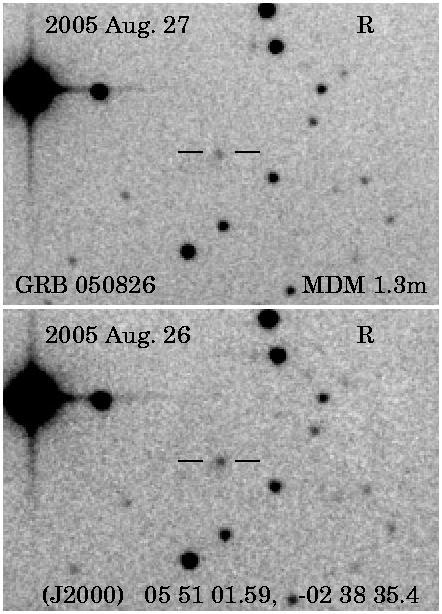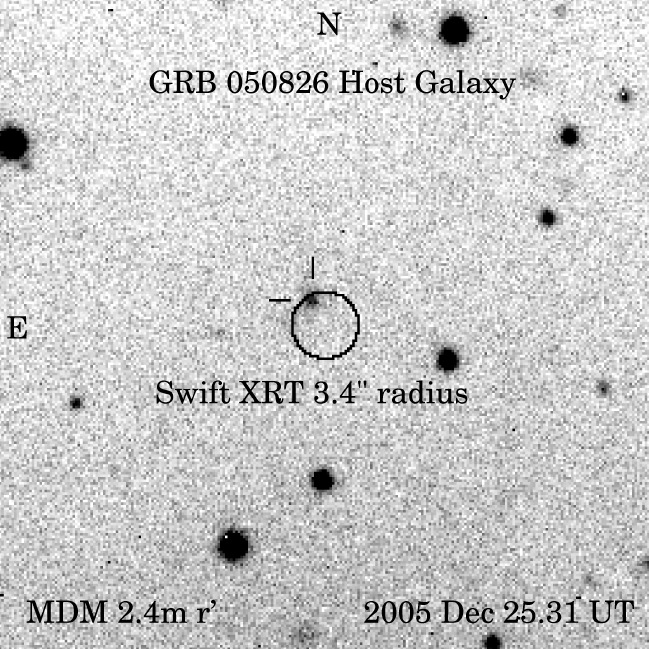 | |
 | |
GRB 050826: Optical Afterglow and Host Galaxy Redshift

|
| GCN Circular #3891 GRB 050826: Optical Candidate |
J. P. Halpern (Columbia U.) reports on behalf of the MDM Observatory GRB follow-up team: "I observed the error box of GRB 050826 (Swift trigger #152113, GCN #3884) in the R band with the MDM 1.3m telescope for 75 minutes on each of two consecutive nights. A fading object not visible on the Digitized Sky Survey is present at coordinates (J2000) 05:51:01.59, -02:38:35.4 (+/- 1") which is 8" from the revised Swift XRT position (error radius 6", GCN #3889). The epochs and magnitudes are: --------------------------------------------------- Date(UT) Time(UT) t-t0(hours) R(mag) --------------------------------------------------- Aug. 26 10:42-11:57 4.40- 5.65 21.0 +/- 0.2 Aug. 27 10:43-11:58 28.42-29.67 21.6 +/- 0.2 --------------------------------------------------- The indicated errors are systematic at this stage of the analysis, but the difference between the two observations is not affected by systematics. Improvements in precision of position and magnitudes will be forthcoming from these data. These preliminary magnitudes should not be used in formal analyses. I also note that this location suffers from significant Galactic extinction, E(B-V)=0.59, A(R)=1.57, according to Schlegel et al. (1998)." |
| MDM 2.4m RETROCAM | GRB 050826 Host Galaxy |

|

|
| GCN Circular #4749
GRB 050826: Optical Afterglow and Host Galaxy |
J. P. Halpern (Columbia U.) and N. Mirabal (U. Michigan) report on behalf of the MDM Observatory GRB follow-up team: "Follow-up observations summarized here support our original suggestion in GCN 3891 of an optical afterglow for the Swift GRB 050826 (GCN 3884, 3888), and indicate the presence of a relatively bright host galaxy for this long burst. First, the Swift XRT position of the afterglow, which was originally determined to lie 8" from the optical candidate with an 90% uncertainty radius of 6" (GCN 3889, 3891), was subsequently refined (as were all XRT positions). In the revised catalog of Moretti et al. (astro-ph/0511604), the XRT position falls only 3.1" from the optical position, consistent with the improved 3.4" X-ray uncertainty. --------------------------------------------------- R.A. (2000) Dec. (2000) +/- (") --------------------------------------------------- Swift XRT 05 51 01.49 -02 38 38.6 3.4 MDM 1.3m OT 05 51 01.58 -02 38 35.8 0.5 MDM 2.4m host 05 51 01.59 -02 38 36.2 0.5 --------------------------------------------------- Second, image subtraction among observations obtained on three consecutive nights on the MDM 1.3m reveals a point-like OT on the first night only, and shows that the light is dominated by the host galaxy on the second and third nights. The OT is offset ~0.4" to the north of the brightest part of the galaxy. ------------------------------------------------------ MDM 1.3m ------------------------------------------------------ Date(UT) Time(UT) t-t0(hours) Diff OT R(mag) ------------------------------------------------------ Aug. 26 10:42-11:57 4.40- 5.65 22.23 +/- 0.15 Aug. 27 10:43-11:58 28.42-29.67 > 22.8 Aug. 28 11:03-11:57 52.75-53.65 ------------------------------------------------------ Date(UT) MDM 2.4m Host R(mag) ------------------------------------------------------ Dec. 25 21.67 +/- 0.05 ------------------------------------------------------ Third, using the MDM 2.4m, RETROCAM imager, and SDSS r' filter on 2005 Dec. 25, a bright core and irregular extension of the presumed host galaxy are clearly resolved in seeing of 1". The host magnitude tabulated above is measured in a 1.8" radius. Optical magnitudes were calibrated with Landolt standard stars, and positions were derived with respect to the USNO B1.0 catalog. The MDM images are posted at http://www.astro.columbia.edu/~jules/grb/050826/ Spectroscopy and deeper imaging are needed to measure the redshift and star-forming properties of the presumed host galaxy. This message may be cited." |

|

|

|
| GCN Circular #5982
GRB 050826: MDM Redshift |
J. P. Halpern & N. Mirabal (Columbia U.) report on behalf of the MDM Observatory GRB follow-up team: "Previously, we reported the detection of the optical afterglow of Swift GRB 050826 within a relatively bright, irregular galaxy of R=21.67, or R=20.1 when corrected for Galactic extinction. Image subtraction was used to separate the OT contribution from the host galaxy. See GCNS 3891 and 4749 for details. On 2006 Dec. 24 UT, we obtained three 1-hour, low-resolution spectra of the host galaxy using the Boller & Chivens CCD Spectrograph (CCDS) on the MDM 2.4m telescope. Acquisition was by blind offset. Narrow emission lines corresponding to [O II] 3727 and [O III] 4959,5007 are seen in the individual exposures. Their line strengths are characteristic of a high-excitation starburst, similar to other hosts of long bursts. From the summed spectrum, we derive a redshift of z=0.297+/-0.001. The Swift BAT fluence of 4.3x10^-7 erg/cm^2 in the 15-150 keV band (Markwardt et al., GCN 3888) then corresponds to an isotropic energy release of 9x10^49 erg using standard cosmological parameters. This example illustrates the role of image subtraction in completing the census of low-luminosity GRBs in nearby galaxies. This message may be cited." |
|
Jules Halpern jules@astro.columbia.edu |
Nestor Mirabal mirabal@umich.edu |
| Back to the main MDM GRB page | |
| Last Modified: January 5, 2007 | jules@astro.columbia.edu |
